This site is still under construction in some areas. Please be patient with our glitches!
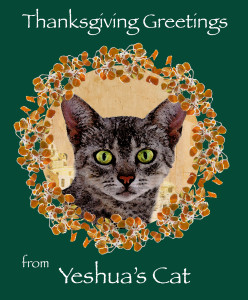
Thanksgiving’s closest parallel in Israel’s year is the Festival of Sukkot, or Booths/Tabernacles, one of the three great Jerusalem pilgrimage festivals. Because of Israel’s lunar calendar, Sukkot, like Passover, falls on different days and even different months each year in our solar calendar, but generally it comes in mid-October.
In the story of Yeshua’s Cat, Sukkot is the time Yeshua and his disciples spend at Bethany, when Lazarus attacks Mari, and Mary of Magdala is healed.
![]()

Sukkot has its roots in Israel’s celebration of the harvest, when they gathered in the fruit of their labors from the fields and vineyards, and celebrated the beginning of the rainy season.
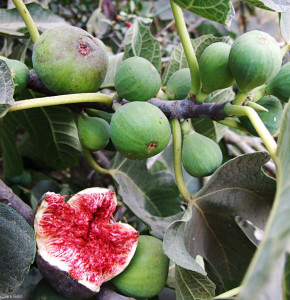 Throughout the week, four species of plants were ceremonially waved (citron fruit, the closed frond of a date palm, and leafy boughs of the myrtle and willow trees) in recognition of the green trees of the land. Wheat, barley, grapes, figs, pomegranates, olives, and dates represented their harvested crops. Above all, the week was a time of rejoicing, and of remembering God’s care for Israel during the years of her wandering in the wilderness and living in tents, or booths.
Throughout the week, four species of plants were ceremonially waved (citron fruit, the closed frond of a date palm, and leafy boughs of the myrtle and willow trees) in recognition of the green trees of the land. Wheat, barley, grapes, figs, pomegranates, olives, and dates represented their harvested crops. Above all, the week was a time of rejoicing, and of remembering God’s care for Israel during the years of her wandering in the wilderness and living in tents, or booths.
 Before the first and holiest day of Sukkot, which came five days after Yom Kippur, each family built a small booth, where they lived together during the festival.
Before the first and holiest day of Sukkot, which came five days after Yom Kippur, each family built a small booth, where they lived together during the festival.
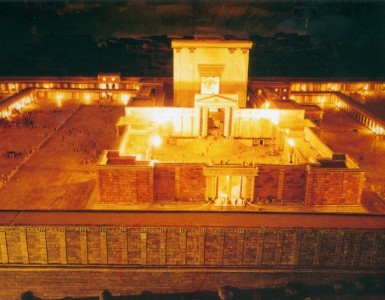
On the day itself, sacrifices of animals and grain began and continued throughout the week. The Illumination of the Temple came at the end of the first day, when four seventy-five-foot candelabras were lit in the Women’s Court of the Temple to remind the people of the pillar of fire that had guided them in the wilderness. Dancing and rejoicing continued through that night, and the whole city was lit by the brilliance of the lamps.
The Pouring of the Water was observed each morning when a priest drew water from the pool of Siloam and poured it on the great altar, as both prayer and thanks for the coming of the rains. Each evening the devout men of Israel gathered at the pool to dance and rejoice with music and torches.
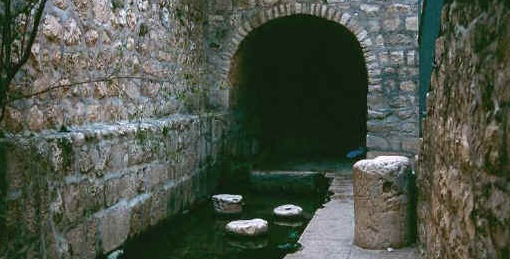
Not only did Sukkot celebrate the gathering in of the crops before the heavy rains and the memory of Israel’s wilderness journey, but also the beginning of the New Year, when the past year’s mistakes had been wiped away, and all the world was new.
.
.
.
“If the Savior considered her worthy, who are you to reject her?” from The Gospel of Mary of Magdala, trans. Karen L. King
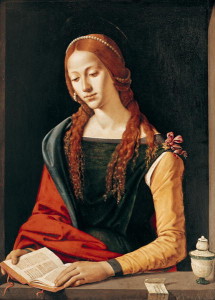
I guess quite a few church leaders over 2 millennia—including Peter, if Mary’s gospel is to be believed—felt comfortable doing just that. Both the Gospel of Mary of Magdala and Mary herself were very nearly buried for two thousand years. Of course she’s practically a cultural icon today, what with her rediscovered gospel, the Da Vinci Code, and even her own opera. If you haven’t kept up with all the brouhaha surrounding her contemporary rehabilitation, try the Smithsonian’s excellent overview, “Who Was Mary Magdalene?” online at http://www.smithsonianmag.com/history/who-was-mary-magdalene-119565482/.
It’s curious that although the gospels’ cast of characters reads like the credits for Peter Jackson’s Lord of the Rings (blink and you’ll miss the women) church fathers still conflated most of the few women mentioned into a composite Mary Magdalene. References to Mary Magdalene’s character in the original texts described her only as previously demon-possessed and a follower of Jesus, helping with his support.

As a result of the pronouncements of such men as Pope Gregory the Great, the two most important women in church tradition became the ever-virgin Mary and the Magdalene montage: a woman taken in adultery, demon possessed, and repenting of great sexual sins. In other words, the virgin and the whore: one of the most common and destructive stereotypes ever devised of women. I should mention that this conflation only happened in the Western, or Roman, church. What is now the Eastern Orthodox Church preserved the older, more balanced view of Mary Magdalene as the Apostle to the Apostles, and companion of Mary the mother of Jesus.
Who was Mary Magdalene really?

I’m staying out of the debate. It’s not my area, and Karen L. King is doing a commendable job of defending my general point of view. But I will say that the now-outdated descriptions of her as a woman with a profligate past should have been buried long before now.
Two major traditions developed around the question of how Mary Magdalene lived her life after the resurrection. According to one, she lived with Mary the mother of Jesus and John in Ephesus, where she eventually died and was buried. According to the other, she went with Lazarus to France, preaching and later living as a penitent hermit wearing only her own hair, and died and was buried there. This latter legend was by far the more popular in Western art, and is the inspiration for Mary Magdalene’s frequent portrayal with long hair and meditating on a skull—as well as the term “maudlin,” derived from “Magdalene” and referring to her constant weeping for her sins.
The evolving legends of Mary Magdalene wove themselves into a fascinating and bizarre bit of history. Among the more macabre elements were the acrimonious claims to what appear to be multiple sets of her earthly remains. Much of the bickering died down after the French Revolution, when many sites claiming to possess her relics were destroyed. Today, in addition to her possible burial places, relics reputed to be hers are still preserved, including a gold-encased skull, a piece of her tibia, a tooth, part of an arm, and a bit of a foot, to name only a few. And that doesn’t begin to account for the second and third class relics.
In case this is alien territory for you, I’ll explain. There are three classes of relics in the Roman Catholic Church: 1st class relics, items relating to Jesus (robe, cross, etc.) or actual bits of saints’ bodies; 2nd class relics, including items used or worn by saints; and 3rd class relics, items that have touched 1st or 2nd class relics. It’s a fascinating subject, spilling into Paul Koudounaris’ amazing newbook, Heavenly Bodies, which documents the discovery of the jeweled skeletons of the “catacomb saints.”
Mary of Magdala is the most important character in Yeshua’s Cat after Yeshua and Mari. And I’ll give you clue: she isn’t a prostitute or a penitent there. But she has always fascinated me in all her incarnations, as you can see below in my digital mosaic, which expresses my own grief over the church’s demonization of Mary.
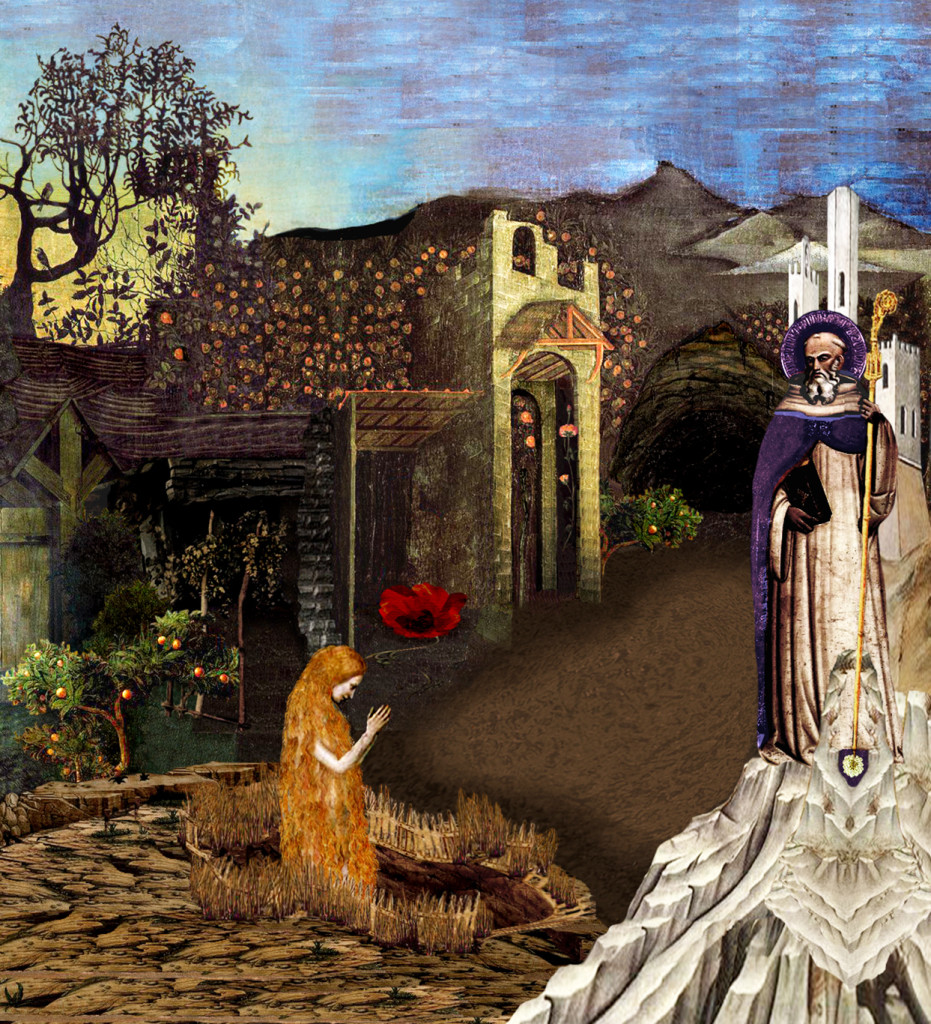
.
.